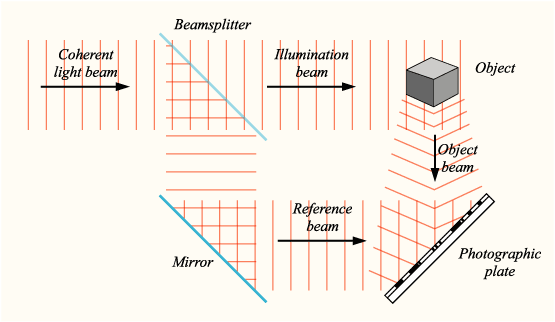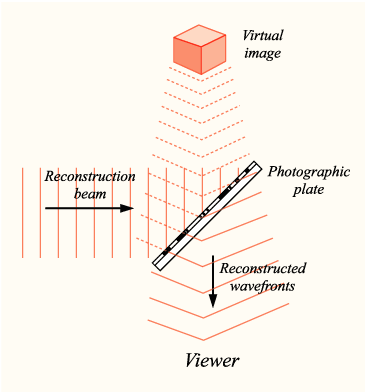
When you hear the term hologram, what is your initial thought? Many people may associate the word with the rising use of human digital projections within the entertainment industry. Holography as a whole, however, has practical applications in various areas. Let’s take a closer look at how this technology works and how researchers are utilizing it today.
Creating 3D Images with Holography
Holography is a technique that captures and records a light field, with the capability of reproducing the original light field in the absence of the initial object. In this process, one laser beam is divided into a reference beam and an object beam. As these split beams later merge on the holographic film, an interference pattern is recorded. This captured pattern forms a hologram.

The recording of a hologram. Image by DrBob, via Wikimedia Commons.
To reconstruct the image, a laser identical to the one used to record the hologram is projected onto the developed film. As it illuminates the recorded hologram on the film, it is diffracted by the surface pattern of the recording. This structures the light in the same exact way it was originally reflected from the initial object. The result? A virtual image right before your eyes — the hologram.

The reconstruction of a hologram. Image by DrBob, via Wikimedia Commons.
How Holographic Technology Has Evolved
This method was first developed by Dennis Gabor in 1948, an invention for which he was awarded the Nobel Prize in Physics in 1971. This discovery was made while Gabor was researching how to enhance the resolution of electron microscopes. Initially, a mercury arc lamp was used as the light source. The low coherency of this light, however, prevented researchers from producing holograms with real depth.
The invention of the laser beam in 1960 made this technique more practical. Featuring a pure and strong light, the laser was an ideal light source for developing holograms. Researchers at the University of Michigan put this new technology to the test in 1962. Combining a laser with an “off-axis technique,” Emmett Leith and Juris Upatnieks successfully enabled the first laser transmission of 3D objects — a toy train and a bird. This enabled the production of images with a clear depth, but a laser light was still needed in order to see the holographic image.
The first transmission hologram viewable in ordinary light was created by Stephen Benton in 1968. This discovery paved the way for the creation of embossed holograms, which can be found on security applications, such as credit cards and passports. The year after Gabor won his Nobel Prize, Lloyd Cross conducted the first successful recording of a moving hologram. He accomplished this by taking ordinary motion picture film and imprinting sequential frames onto holographic film.
With new technological advancements, creating holograms has become a more affordable process. Previously requiring the use of expensive high-powered lasers, holograms can now be mass produced thanks to the advent of new low-cost lasers. This has made holography a more accessible resource for research initiatives.
The Development of Holographic Devices
In recent years, many devices have been designed to utilize holographic technology. In Italy, researchers have developed a new lens-free, holographic imaging technique that could help firefighters see clearly through smoke and fire in rescue attempts.
The infrared cameras typically used in these situations are often saturated by the radiation that is emitted from the flames of fire. This new camera system eliminates the need for a zoom lens and, in doing so, prevents firefighters’ vision from being impaired by the smoke and radiation from the flames. The new camera’s ability to provide 3D images of what lies beyond the frame is particularly unique. Infrared light, from a infrared laser light beam, reflects off people and objects in a room and is recorded by a holographic imager, generating a live 3D movie of the room. (Reading tip: Check out this blog post on indoor navigation for another technology designed to help firefighters.)
The medical field has used holography to build technology that allows for greater personalized health monitoring. At the University of Cambridge, researchers have developed holograms that respond to the presence of particular compounds by changing their color.
These holograms are designed using hydrogel infused with small particles of silver. A single laser pulse causes the silver nanoparticles to form 3D holograms of predetermined shapes — a process that occurs in a fraction of a second. The presence of certain compounds in a person’s breath or bodily fluid causes the hydrogels to condense or expand, which, in turn, results in a color change. The resulting color can then be compared to a chart, helping individuals to diagnose potential diseases and conditions at an earlier stage.



Comments (0)